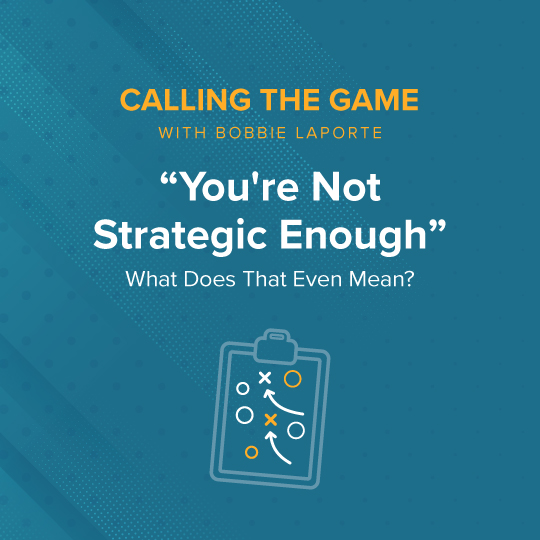Ever been told you’re “not strategic enough” and wondered that even means? Bobbie LaPorte has worked with plenty of clients over the past two decades who felt both confused and frustrated when given this kind of vague feedback. In her November 14 “Calling the Game” video, she shares a few ideas to help make your “strategic” side shine through.
Three Practical Ways to Make Your Strategic Leadership Visible, Actionable, and Impactful
I have a question for you: How often have you been told that you are ‘not strategic enough’? Really? So what does that mean?
Has whoever said that to you also shared what that means? Like, what are the behaviors that exhibit being strategic? How will your work change? In what way will the outcomes, as well as your leadership impact, change?
I am guessing that:
(1) you have heard that more than once in your career.
(2) it’s likely no one gave you any specifics about what that looks like or how to get there.
At least, that’s been the experience my clients have shared with me over the last two decades.
That can be frustrating and confusing, no doubt. Everyone has different ideas about what “being strategic” means, but what I do know is it is not some planning meeting you attend on a regular basis and then go about your daily routine.
Your strategy needs to connect and inform what you do as a leader every day – with your team, peers, and internal stakeholders.
So (assuming you have a strategy), I want to offer three ideas to make that strategy visible, real, and accessible to everyone:
- Put your strategy in the context of some shared framework that already exists in your organization – like OKRs, KPIs, or whatever enterprise-wide goal structure everyone shares and understands. This helps everyone be aligned on what you and your team are working toward and how it supports the goals of your colleagues and stakeholders. This might seem obvious, but I have been surprised at how many leaders don’t take this important step.
- Make your strategy relatable to your team to help them see how their own work contributes to and impacts the broader strategic objectives of the organization. Not only does this create connection and cohesion, but it helps them feel part of a larger mission and purpose, and helps you promote the contributions of your team. Ask questions like, “How does this initiative support our long-term objectives?” to guide the conversation toward big-picture thinking.
- Develop a rallying cry for your team – something that will remind them of their purpose in a fun and memorable way. It might seem a bit corny, but that’s okay. Like Just Do It: from Nike or ThinkDifferent from Apple. Yours can be anything that represents the essence of your strategy in action: how you expect your team to act, how you will know they ‘get it.’ A good rallying cry should be memorable and concise, and it should connect with people on both a rational and emotional level. Have your team help to craft this, and then include it in your meeting agendas, use it to showcase examples of how it drove successes, and have some fun with it.
Being told you’re not strategic enough can be frustrating and confusing. But if you take it to heart and act on it, it can be the key to strengthening your leadership, building support with your team and internal stakeholders, and increasing the visibility of your impact. When the strategy is seen, understood, and actionable, good things will happen.
To support you in calling your own game, I am offering my 30-minute online Introduction to Navigating Uncertainty course free to viewers for a limited time. Click on the link to sign up now!


